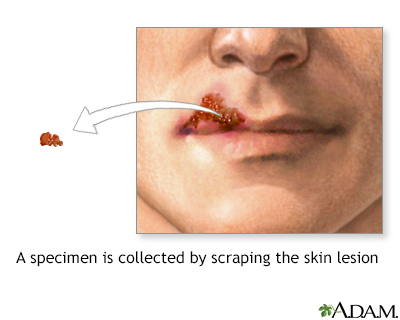Herpes viral culture of lesion
Definition
Herpes viral culture of a lesion is a laboratory test to check if a skin sore is infected with the herpes virus.
Alternative Names
Culture - herpes simplex virus; Herpes simplex virus culture; Herpes zoster virus culture
How the Test is Performed
The health care provider collects the sample from a skin sore (lesion). This is done usually by rubbing a small cotton swab and on the skin lesion. The sample is sent to a lab. There, it is placed in a special dish (culture). It is then watched to see if the herpes simplex virus (HSV), herpes zoster virus, or substances related to the virus grow. Special tests may also be done to determine whether it is HSV type 1 or 2.
How to Prepare for the Test
The sample must be collected during the acute phase of infection. This is the worst part of an outbreak. It is also when the skin lesions are at their worst.
How the Test will Feel
When the sample is collected, you may feel an uncomfortable scraping or sticky sensation. Sometimes a sample from the throat or eyes is needed. This involves rubbing a sterile swab against the eye or in the throat.
Why the Test is Performed
The test is done to confirm herpes infection. Herpes simplex virus causes genital herpes. It can also cause cold sores of the mouth and lips. Herpes zoster causes chickenpox and shingles.
The diagnosis is often made by physical examination (the provider looking at the sores). The cultures and other tests are used to confirm the diagnosis.
This test is most likely accurate when a person is newly infected, that is, during the first outbreak.
Normal Results
A normal (negative) result means that the herpes simplex virus did not grow in the laboratory dish and the skin sample used in the test did not contain any herpes virus.
Be aware that a normal (negative) culture does not always mean that you do not have a herpes infection or have not had one in the past.
What Abnormal Results Mean
An abnormal (positive) result may mean that you have an active infection with herpes simplex virus. Herpes infections include genital herpes, cold sores on the lips or in the mouth, or shingles. More blood tests will likely be needed to confirm the diagnosis or the exact cause.
If the culture is positive for herpes, you may have recently become infected. You may have become infected in the past and are currently having an outbreak.
Risks
Risks include slight bleeding or discomfort in the area where the skin was swabbed.
Gallery

References
Marks JG, Miller JJ. Dermatologic therapy and procedures. In: Marks JG, Miller JJ, eds. Lookingbill and Marks' Principles of Dermatology. 6th ed. Philadelphia, PA: Elsevier; 2019:chap 4.
Plourde AR, Beavis KG. Specimen collection and handling for diagnosis of infectious diseases. In: McPherson RA, Pincus MR, eds. Henry's Clinical Diagnosis and Management by Laboratory Methods. 24th ed. Philadelphia, PA: Elsevier; 2022:chap 66.
Whitley RJ, Gnann JW. Herpes simplex virus infections. In: Goldman L, Schafer AI, eds. Goldman-Cecil Medicine. 26th ed. Philadelphia, PA: Elsevier; 2020:chap 350.